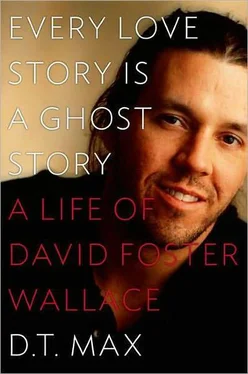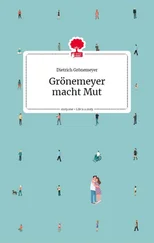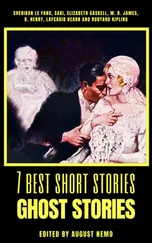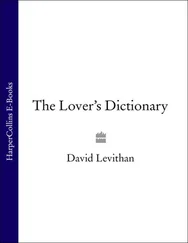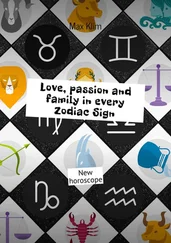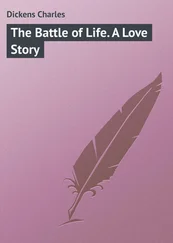Wallace had not been waiting for Pietsch’s response to resume writing. By the time he left for Illinois in July 1993, as he later told an interviewer, he had reached the scene in which Gately is shot protecting his charges at Ennet House, nearly three-quarters of the way through the story. Likely Wallace had more in rougher form. But the combination of the memo and the move to Illinois deflated him. He was home in Illinois again, or nearly, and near home he often found his momentum dissipating. He spent many summer days staring at the ceiling of his new home. He asked a friend from Syracuse to call him every night to make sure he had written, hoping that guilt would spur him to productivity, but the trick did not work.
Wallace had been stumped in a similar way when he moved to Syracuse, and he drew again on the patience and endurance he had learned in recovery to try to get past the roadblock. But as he was settling down to get back to work, a distracting nonfiction project came his way. The editors at Harper’s were longtime fans of his writing. In 1991, they had published “Tennis, Trigonometry, Tornadoes,” his fanciful remembrance of his high school sports life, and, a year later, an adept parody of John Updike’s Rabbit books called “Rabbit Resurrected.” Updike had been an early love of Wallace’s, before he had awoken to literature, and even now he was stunned by the grace and ease with which Updike wrote. But as he’d changed his attitude toward his own work he had reconceived of Updike as part of the American problem, and of Rabbit Angstrom, his principal character, as symptomatic of the prison of self-absorption and egoism that afflicted so many Americans. There was nothing outside his priapic neediness. Rabbit had died in the fourth installment in the series, Rabbit at Rest , published in 1990. Wallace imagined the next chapter in the pages of Harper’s , resurrecting Rabbit into “a solipsist’s heaven, full of his own dead perceptions.” Rabbit asks, “Would there be vaginas, where he was going, vaginas finally freed from the shrill silly vessels around them, bodiless, pungent, and rubicund, swaddled in angelic linen…the odd breast or two, detached, obliging?”
Despite not having taken his television essay, the Harper’s editors were again on the lookout for assignments to give Wallace. So, soon after they learned he was returning to the Midwest, they asked him if he wanted to go to the state fair. The fair was a massive event, with thousands of booths and tens of thousands of visitors attending its 4H shows, dance competitions, and junior boxing tournaments. Wallace hesitated. He worried that he had never done reporting — to his mind the failed pornography piece no longer counted. But he was intrigued too, eager to make some money, and happy for the chance to escape his own head and see a different side of his native region.
Wallace cast around for someone to go with him, asking Costello, Charlie and Victoria Harris, and in the end chose their daughter, whom he then barely knew. In August, in the sweltering Midwest summer heat, he and Kymberley drove to Springfield, the state capital. At the fair, they visited the Horse Complex and the Swine Barn, and then went on to the amusement ride section. Harris took a ride called the Zipper, a steel cage that spun at the end of a long elevated arm. Wallace was not thrilled to watch his new friend get lifted away, and was thoroughly mortified when the ride operators — he called them “carnies”—kept flipping the cage around to make Harris’s skirt fall up. When they finally brought her back to earth, Wallace was furious. He wanted to press charges. Harris told him it was no big deal, but Wallace remained upset. Harris went home the next day, and Wallace continued his reporting. He chatted with the local evangelists and watched a car race without interest (“Certain cars pass other cars, and some people cheer when they do”). A dance competition touched him more deeply, when he saw how sincere was the pleasure the ordinary midwestern couples took in it, a moment worthy of Sullivan’s Travels .
Back home in Bloomington, surrounded by his Infinite Jest research material, he sat down to try to organize his notes. He put a layer of myth over his experience. In Wallace’s telling, the Illinois fair grew increasingly Boschian as the days went on. Drawing on his gift for comic exaggeration and not particularly worried by veracity, by the end, bald men farted as they arm-wrestled, vomit spewed from the mouths of patrons being spun in the Ring of Fire, and, at the “Illinois State Jr. Baton-Twirling Finals,” the insanity reaches a kind of climax as
a dad standing up near the top of the stands with a Toshiba video camera to his eye takes a tomahawking baton directly in the groin and falls over on somebody eating a funnel cake, and they take out good bits of several rows below them.
Harris became an old heartthrob, someone who “worked detasseling summer corn with me in high school.” She was in real life neither “a Native Companion,” as Wallace called her in the article, nor a graduate of Urbana High — that was more Susie Perkins or his sister. And when it was time for Native Companion to speak, Wallace gave Harris the voice of the woman whose star still twinkled over his head. “Oh for fuck’s sake,” Native Companion reproofs the upset Wallace after being exposed during the Zipper ride, “it was fun — son of a bitch spun that car sixteen times…. Buy me some pork skins, you dipshit.”
Wallace took pleasure in writing the piece. For him, the challenge in nonfiction was always what to leave out, but the state fair was a subject with natural boundaries and one that invited a light style that moved to bigger, more serious questions: What made Americans so obsessed with entertainment? Could whatever void they were trying to plug ever be filled? It helped that at the fair the people were gluttons and the animals miserable. It was another chance to assert the thesis of Infinite Jest , to anatomize the unending American quest for distraction, the failure of his countryman, as Remy Marathe, the Quebecois terrorist agent, 2says in Infinite Jest , “Choose with care. You are what you love. No?” 3
Shortly after, Wallace sent in his long draft, several times the possible length of the piece. Colin Harrison, the editor, set to work cutting with Wallace. The process reminded Harrison of a game of tennis, the prospective edits turning into “here’s-what-I-think, what-do-you-think rallies that sometimes went on for many minutes,” as he wrote in a remembrance, and ended with a cut accepted or partially accepted or traded off for a cut somewhere else. Wallace was strategic and aggressive, but when he lost a point, he moved on. Together they shortened the piece almost by half. Harrison, an experienced editor, was aware that Wallace sometimes embellished. At one point, he asked Wallace if a vial of crack that Wallace reported had fallen out of the pocket of a young man on the Zipper had really “direct-hit a state trooper alertly eating a Lemon Push-Up on the midway below.” Wallace was coy. “I’m going to give you this one,” Harrison remembers saying. He wanted Wallace to pursue his comic vision. “I drank the Kool-Aid,” he recalls. So if Wallace wrote it, it aided the narrative energy, and could not be disproven when the piece was fact-checked, it could run. 4, 5
The article, which came out the next July, also unveiled a new Wallace to readers, neither the creator of elaborate fictional worlds nor the Cavellian essayist but someone more of a piece with the characters in his fiction. At one point, Wallace describes being too afraid to go into the Poultry Building, explaining that as a child he had once been attacked by a chicken “without provocation, flown at and pecked by a renegade fowl, savagely, just under the right eye.” The story was likely made up, but its exaggerated stance toward the traumas of childhood captured something readers began to want from him. They, too, this affluent and confused generation, had felt the large reverberations inherent in small events. That Wallace was a slightly more neurotic version of his reader helped forge a bond, a bond that would carry over when he published his very big novel.
Читать дальше
